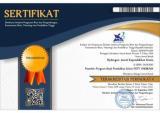Karakterisasi Panjang Gelombang Tanaman Daun Bebele dan Kangkung yang Tumbuh Di Pulau Lombok Sebagai Dye Sensitized Solar Cell (DSSC)
Abstract
derived from organic and inorganic materials. The choice of natural dyes is
preferred by looking at the enormous potential of biodiversity in Indonesia,
where there are still many untapped especially for plants that have a tendency to
be colored or contain chromophore dyes such as chlorophyll (play a role in the
absorption of light for photosynthesis). The wavelength when characterizing the
dye as a solar cell must be in the visible area (400 to 800nm). In this study the
natural dyes used are bebele leaves and kangkung which grow on the island of
Lombok. The wavelength obtained for fresh bebele is 553nm, 605 nm and 665nm.
The wavelength obtained for fresh kangkung leaf is 664.5 nm with the highest
absorption peak. From the results of the absorption stated that natural dyes have
chlorophyll a and b groups which are absorbed in the UV-Vis region 600nm to
700nm which means that they absorb the red most strongly. In the measurement
of current strength and efficiency with multimeters on organic dyes in a row that
is fresh bebele leaves5 μA /cm2; 0.156; fresh kangkung leaves 4.2 μA/cm2; 0,131;
dried bebele leaves 4 μA/cm2; 0.13; dried kangkung leaf 3 μA /cm2; 0.088.
Keywords
Full Text:
PDFReferences
Agrell G.H., 2003, Interactions in Dye Sensitized Solar Cells, ACTA University UPSALA.
Akhlus, Syafsir (2007), “Studi Pemanfaatan Ekstrak Mangsi sebagai Fotosensitizer Dalam
Pembuatan Dye-Sensitized Solar Cell (DSSC)”, Institut Teknologi Sepuluh Nopember,
Surabaya.
Balraju P., Manish Kumar, M.S. Roy, dan G.D. Sharma (2009), “Dye sensitize d solar cells
(DSSCs) based on modified iron phthalocyanine nanostructured TiO2 electrode and
PEDOT:PSS counter electrode”, Synthetic Metal, Vol. 159, Hal. 1325-1331.
Brammer, Tate (2004), Nanostructured Titania Dye Sensitised Solar Cells: Study of the
effects of variations in the TiO2 Film Thickness and Dyeing Time, Master Thesis,
University of Quennsland, Australia.
Cahen, David, Juan Bisquert, Gary Hodes, Sven Ru1hle, dan Arie Zaban (2004), “Review
Articles: “Physical Chemical Principles of Photovoltaic Conversion with Nanoparticulate,
Mesoporous Dye Sensitized Solar Cells”, Journal Physics Chemistry B, Vol. 108, hal.
– 8118.
Cherubin, Naumissing Sao (2009), Dye-Sensitized Solar Cells Based on Perylene
Derivatives, Desertation, University of Kassel, Germany.
Daiq dan Rabbani (2002), Photosensitization of Nanocrystalline TiO2 Films by Anthocyanin
Dyes, Jurnal photochem, photobiology.A:chem., Vol. 148, hal. 17-24.
Deville, Marie-Helene (1999), “Organometallic electron reservoir sandwich iron complexes
as potential agents for redox and electron transfer chain catalysis”, Inorganica Chemica
Acta, Vol. 291, hal. 1-19.
Duncan, Walter R, dan Oleg V. Prezhdo (2007), “Theoretical Studies of Photoinduced
Electron Transfer in Dye-Sensitized TiO2”, Annual Review of Physical Chemistry,Vol.
, hal. 143–84.
De Paoli, Marco, dan Claudia Longo (2003), “Dye-Sensitized Solar Cell : A Succesful
Combination of Materials,” Journal Brazillian Chemistry Society, Vol. 14, No 6, hal.
– 901.
DOI: https://doi.org/10.33394/hjkk.v6i1.1599
Refbacks
- There are currently no refbacks.

This work is licensed under a Creative Commons Attribution-ShareAlike 4.0 International License.





